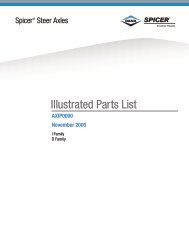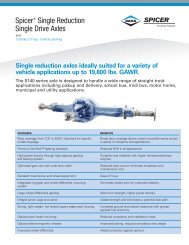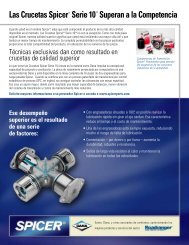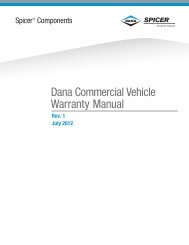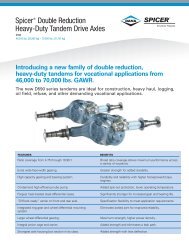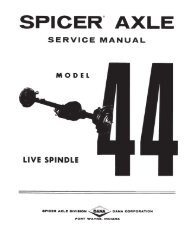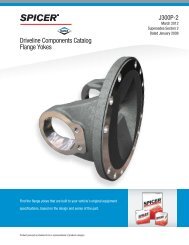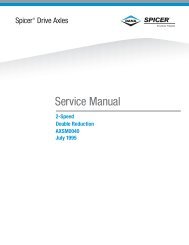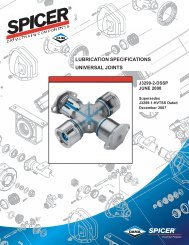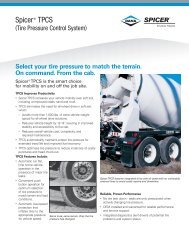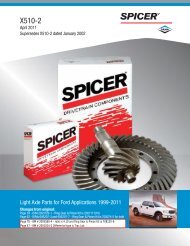Service Manual - Dana Corporation
Service Manual - Dana Corporation
Service Manual - Dana Corporation
Create successful ePaper yourself
Turn your PDF publications into a flip-book with our unique Google optimized e-Paper software.
Adjustments<br />
Differential/ Carrier Adjustments<br />
Adjustments help provide optimum axle life and performance by correctly<br />
positioning bearings and gears under load.<br />
single drive axles require two types of adjustments: Bearings must be<br />
preloaded and ring gear tooth contact must be set.<br />
Bearing Preload — Both pinion and differential bearings Adjust Pinion Bearing Preload — Most axles<br />
require preloading. The adjustment procedures seat will be found with a “slip-fit” outer pinion bearing,<br />
these bearings in their cups for good support and free but recent design changes provide a “press-fit” on<br />
rotation under load. The pinion pilot bearing does not this bearing (in some axle models). Procedures for<br />
require a preload adjustment. adjusting both types of pinion bearing design are<br />
contained in this section.<br />
Adjust Pinion Bearing Preload for Axles With<br />
"Press-fit” Outer Pinion Bearings<br />
Trial Build-up<br />
1. Assemble the pinion bearing<br />
cage, bearings and spacer (without<br />
drive pinion or oil seal).<br />
NOTE: During assembly procedure,<br />
center bearing spacer<br />
(and spacer washer when used)<br />
between the two bearing cones.<br />
2. With the bearings well lubricated,<br />
place the assembly in the<br />
press. Position a sleeve or spacer<br />
so that load is applied directly to<br />
the back face of the outer bearing<br />
cone.<br />
Assemble these Parts for Trial Build-up.<br />
Axle Series<br />
16<br />
17/1 8/21<br />
22<br />
19/20/23/26/30<br />
3. Apply press load to the<br />
assembly and check rolling<br />
torque. Wrap soft wire around the<br />
bearing cage, attach spring scale<br />
and pull. Preload is correct when<br />
torque required to rotate the<br />
pinion bearing cage is from 10-<br />
20 inch pounds. This specification<br />
is translated into spring scale<br />
readings in the chart below.<br />
4. If necessary, Adjust Pinion<br />
Bearing Preload by changing the<br />
pinion bearing spacer. A thicker<br />
spacer will decrease preload. A<br />
thinner spacer will increase<br />
preload.<br />
Specifications for Pinion Bearing<br />
Trial Build-up Preload Test<br />
(“Press-fit” Outer Pinion Bearings)<br />
Nominal Bearing<br />
Spacer Thickness<br />
in.<br />
mm.<br />
0 . 5 2 8 13.41<br />
0.638<br />
0.638<br />
0.638<br />
0.185<br />
16.21<br />
16.21<br />
16.21<br />
4.70<br />
Cage in Press<br />
to Check Bearing<br />
Preload.<br />
Press Loads<br />
Tons Metric Tons<br />
12-13 11-12<br />
1 1 - 1 2 10-11<br />
14-15 13-14<br />
14-15 13-14<br />
19-20 17-18<br />
IMPORTANT: Once correct bearing<br />
preload has been established,<br />
note the spacer size used. Select a<br />
spacer 0.001” larger for use in the<br />
final pinion bearing cage assembly.<br />
The larger spacer compensates<br />
for slight “growth” in the bearings<br />
which occurs when they are<br />
pressed on the pinion shank. The<br />
trial build-up will result in proper<br />
pinion bearing preload in three<br />
of four cases.<br />
IMPORTANT: Do not assume that<br />
all assemblies will retain proper<br />
preload once bearings are pressed<br />
on pinion shank. FINAL PRELOAD<br />
TEST MUST BE MADE IN EVERY<br />
CASE.<br />
Spring Scale Reading<br />
(without pinion seal)<br />
(for 10-20 m-lbs. torque)<br />
(1.1-2.3 N•m)<br />
lb.s kgs.<br />
5-9 2.3-4.1<br />
5-9 2.3-4.1<br />
4-8 1.8-3.6<br />
4-7 1.8-3.2<br />
3-7 1.4-3.2<br />
13



